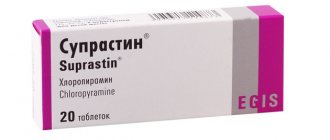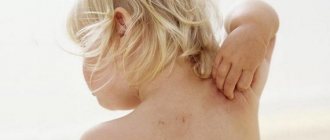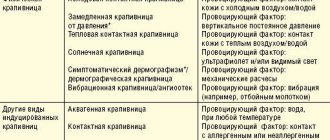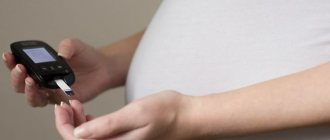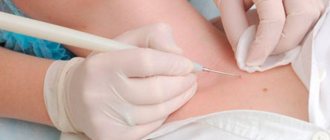Atopic dermatitis in children is a chronic, recurrent inflammatory skin disease with an immune mechanism. As a result of hypersensitivity reactions to various antigens (food products, pneumoallergens, bacterial proteins), a number of inflammatory factors are released in genetically predisposed children.
This results in eczematous lesions, which consist of edema and microvesicles, leading to itching, irritation, scratching and inflammatory lesions, symmetrical, varying in appearance and location depending on the age of the child. It is often associated with asthma, rhinitis and food allergies.
Types of atopic dermatitis
Experts identify the following types of disease:
- Infant (from birth to 2 years). The first signs appear in the first months of life. The rash is localized in the cheeks and forehead. This type of disease is popularly called diathesis. Affected areas become wet and swollen
- Children (from 2 to 12 years old). It worsens when the skin comes into contact with an irritant. It is characterized by excessive dryness and itching.
Depending on the pathogen, there are the following clinical and etiological options: food, fungal, tick-borne and pollen. A type of disease with secondary infection is also distinguished.
Reasons for development
Childhood atopic dermatitis is a public health problem in developed countries and has a prevalence of 10 to 20%. Within the same country, rates are higher in urban areas and among populations with higher standards of living. With age, the prevalence and intensity of the disease decrease. 60% of patients are diagnosed in the first year of life, mainly in the first six months, in 85% in the first 5 years and only in 10% after 7 years.
In 70-80% of patients it develops against the background of a hereditary predisposition. The genetic basis is combined with various immunological changes in the skin, which cause dysfunction of the protective barrier:
- mutations lead to the appearance of microcracks, transepidermal loss of moisture and pH imbalance;
- this facilitates the entry of environmental irritants, allergens (mites, food, pollen) that increase sensitivity, and pathogens such as Staphylococcus aureus.
These factors lead to cellular infiltration of the dermis and constant inflammation with an initial imbalance of lymphocytes that produce Ig E upon contact with allergens. Subclinical inflammation persists even beyond exacerbation
Main causes of the disease:
- Excessive dryness. Patients have a defect that prevents the skin from moisturizing. The situation is especially worse in winter due to the use of heaters and reduced indoor humidity. Frequent washing without subsequent moisturizing also dries.
- Stimulus. Various household chemicals and low-quality care products can cause burning, redness, itching or dryness.
- Emotional stress. Sheer disappointment, fear and anger are provocateurs to which the child’s skin reacts with itching and redness.
- Excessive sweating. If clothing is not appropriate for the weather, the skin performs the function of thermoregulation - it sweats, which leads to a worsening of the clinical picture.
Separately, infection with staphylococcus should be considered. In this case, outlined areas or vesicles with pus appear. The disease can be caused by herpes and fungus. In rare cases, pollen, dust mites and pets cause atopic dermatitis in very young children.
Symptoms of atopic dermatitis in children
Clinical manifestations form the basis of diagnosis, as there are no specific microscopic or laboratory changes.
Main manifestations depending on age:
- Babies. Signs of the disease appear from the second month, with erythematous exanthema, with a large exudative component that forms scabs and is localized on the cheeks, forehead, and also affects the nasolabial triangle. Distributes symmetrically to the scalp, front part of the body and limbs. The diaper area is usually left untouched.
- Children from 2 to 12 years old. Skin manifestations may begin at this stage or recur after a free interval of up to 2-3 years. Localization is typical on the elbow bends and popliteal folds. There is a characteristic itching in the affected area. Other typical sites include the thighs, wrists, eyelids, hands and fingers.
- Teenagers. Papular and lichen-like lesions predominate in this phase based on intense xerosis. It is predominantly localized in large folds, on the upper third of the arms and back, the back of the arms and legs, and on the fingers.
Symptoms that should alert parents: dry skin, small cracks in the crease of the earlobe, fingers and toes, redness and peeling on the back of the toes or mouth. Hyperkeratosis, which gives the appearance of goosebumps, is localized on the buttocks, deltoid region, outer thighs and torso. Erythematous plaques on the cheeks, dark circles under the eyes and pallor may occur.
What is dermatitis?
Dermatitis is a skin reaction to external irritants of a biological, physical or chemical nature.
The disease manifests itself in the form of irritation on the skin and can cause the baby not only physical, but also emotional discomfort. The most typical manifestations of dermatitis include:
- redness,
- peeling of the skin,
- rashes that cause itching and pain.
However, dermatitis is not so scary if you know the reasons for its occurrence, be able to distinguish it from other diseases, carry out prevention and seek help from a specialist in a timely manner.
Possible complications
Complications of atopic dermatitis in children:
- Asthma and allergic rhinitis (hay fever). Sometimes eczema precedes these diseases. More than half of young children with atopic dermatitis develop asthma and allergic rhinitis by age 13.
- Chronic itching and flaking. This disorder can cause the affected area to change color and become thicker.
- Skin infections. Infection increases the risk of contracting bacteria and viruses, such as the herpes simplex virus.
- Allergic contact dermatitis. This disease often occurs in patients with atopic dermatitis.
- Sleep problems. The characteristic severe itching can lead to insomnia.
Diagnosis of atopic dermatitis
A test for general and specific Ig E is prescribed to determine the cause of skin inflammation. The doctor makes the diagnosis by examining the affected areas and taking a medical history. The specialist may also use patch tests or other tests to rule out other skin conditions.
If parents suspect that a certain food was the cause of a rash on the child’s body, then they need to inform the doctor about this and ask about the possibility of identifying potential food allergens. In this case, a diet is prescribed for treatment.
What are the causes of the disease?
It is necessary to distinguish between the cause and triggers of atopic dermatitis.
The reason is not fully known to modern science; the main version is a set of genetic, immune and skin changes, in particular, a deficiency of the skin protein filaggrin, which is responsible for retaining moisture in the skin.
The triggers of atopic dermatitis are very diverse, atopic skin is overly sensitive to irritation, so exacerbation can be caused by increased sweating, heat, rough clothing, detergents, dry air, etc. Children with atopic dermatitis may simultaneously have allergies to food, household or other animals, dust mites, tree and grass pollen - these allergens can also be triggers for exacerbations.
In general, atopic dermatitis has a wave-like course, periods of exacerbations (most often occurring for unobvious reasons or for no reason) are replaced by periods of remission - hence there is a great temptation to associate exacerbations with factors that are not directly related to the disease, and vice versa - to attribute healing properties to completely extraneous factors (for example, a diet that parents started by mistake or out of desperation).
It is impossible not to mention the established harmful domestic tradition of calling atopic dermatitis allergic (usually associating it with an allergy to cow’s milk protein) and treating it with diets (a strict “hypoallergenic” diet for a nursing mother, and/or a hydrolysis/amino acid mixture for a child). Indeed, if a child has an intolerance to cow's milk proteins, it may aggravate or cause atopic dermatitis, but not vice versa. Not every child with atopic dermatitis has an intolerance to cow's milk proteins or any other allergens. This means that by prescribing a diet, or an expensive and unpleasant-tasting mixture, the doctor adds problems to the family without helping them. In most cases of atopic dermatitis, identifying allergies and excluding allergens does not provide any benefit.
Treatment of atopic dermatitis in children
Atopic dermatitis can be permanent. You may need to try multiple treatments over several months or years to control the disease. Even if treatment is successful, signs and symptoms may reappear.
Early detection of the disease allows timely treatment to begin. That is why, when primary symptoms appear, you need to contact an allergist-immunologist or dermatologist.
If regular moisturizing and other personal hygiene measures do not help, your doctor may suggest medication:
- Corticosteroid ointments. Relieve itching and help restore skin. Apply them according to the instructions after moisturizing the skin to avoid adverse reactions.
- Calcineurin inhibitors. Ointments are prescribed for ages 2 years and older. Affect the immune system. Avoid intense sunlight when using these products.
- Medicines to fight infection. Antibacterial cream is prescribed for bacterial infections, open sores or cracks. Oral antibacterial drugs may also be prescribed.
- Medicines to control inflammation. In severe cases, your doctor may prescribe oral corticosteroids.
Effective and intensive treatment for severe forms of the disease involves wrapping the affected area with topical corticosteroids and moist dressings. The procedure is performed under the supervision of medical professionals.
Phototherapy (light therapy) is prescribed to children whose condition does not improve with local treatment. The procedure involves exposure to a controlled amount of natural sunlight alone or in combination with medications.
Although effective, long-term phototherapy has detrimental effects, such as premature aging and an increased risk of cancer. For these reasons, phototherapy is not often used in young children and is not performed in infants.
Diaper dermatitis - symptoms and treatment
The prognosis is favorable. In the vast majority of cases, the disease is not dangerous and, as a rule, does not require specific medications. It usually goes away on its own after stopping the use of diapers and performing proper skin care [18].
To prevent diaper dermatitis, a set of measures is used: ABCDE (abbreviation for English words):
- A - air (air);
- B—barrier;
- C - cleansing (cleansing);
- D - diapering (diaper changing)
- E - education (training).
Air - air . This means frequent air baths when the child is not wearing a diaper. It is recommended to carry out air baths for at least 5-10 minutes when changing a diaper [19].
Barrier - barrier . Use of protective creams. Their application is necessary every time you change diapers. Most often they contain zinc, dexpanthenol, petroleum jelly, and lanolin. These creams create a protective film that separates the skin from the irritating effects of urine and feces.
Cleansing - cleansing . If the skin in the diaper area is inflamed, a daily bath will help remove irritants and reduce the risk of fungal and bacterial infections. Cleaning is carried out with water, it should be gentle, you can use cotton balls or cotton cloth. Baby wipes should only be used on intact skin. They should not contain parabens, alcohol, fragrances, irritants or allergens, and the pH should be neutral. After bathing, you need to gently pat your skin with a towel, avoiding friction [20].
Diapering - changing diapers . Diapers should be changed every 2 hours (every hour for newborns) or after each bowel movement or urination. It is better to choose a diaper with high absorbency. The better the diaper absorbs, the better it keeps the skin dry. Although there is currently no data showing which type of diaper is best for preventing diaper rash, cloth diapers are generally less absorbent than most disposable diapers. If a child develops diaper dermatitis while using cloth diapers, then it is better to switch to disposable diapers during the illness. You need to make sure that the diaper is not too tight, especially when worn at night. A loose diaper will rub less against your skin. Let your baby's skin dry completely before putting on a new diaper. It is also important to prevent the sticky pads from sticking to your baby's skin. Hands should be washed before and after changing diapers to prevent the spread of germs that have caused infection on the baby's skin [21].
Education - training . Educating parents on proper child care is important. It is necessary to provide them with clear instructions regarding daily skin care and information about which skin care products are beneficial and which may be harmful [22].
Disease prevention
The following recommendations are aimed at preventing episodes of illness and minimizing the effects of dryness after bathing:
- Moisturize your skin at least twice a day. Use creams, ointments, or lotions that lock in moisture. Select one or more products suitable for your child.
- Try to identify and avoid triggers that make the condition worse. Prevent stress, negative effects of pollen dust. Dress your child according to the season to prevent him from sweating.
- Infants and children may experience flare-ups when consuming certain foods, such as eggs, milk, soy, and wheat. Talk to your doctor about how to identify possible food allergens.
- Use only mild soap. Choose products with a neutral pH level. Antibacterial soap removes natural oils and dries out the skin.
Water procedures should not exceed 10-15 minutes. After your bath, dry your skin gently with a soft towel and apply a moisturizer.



